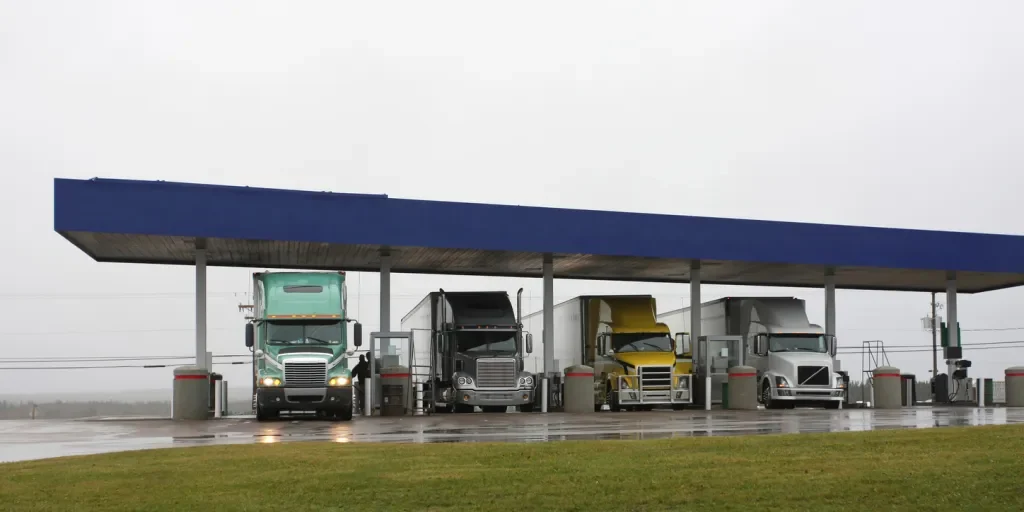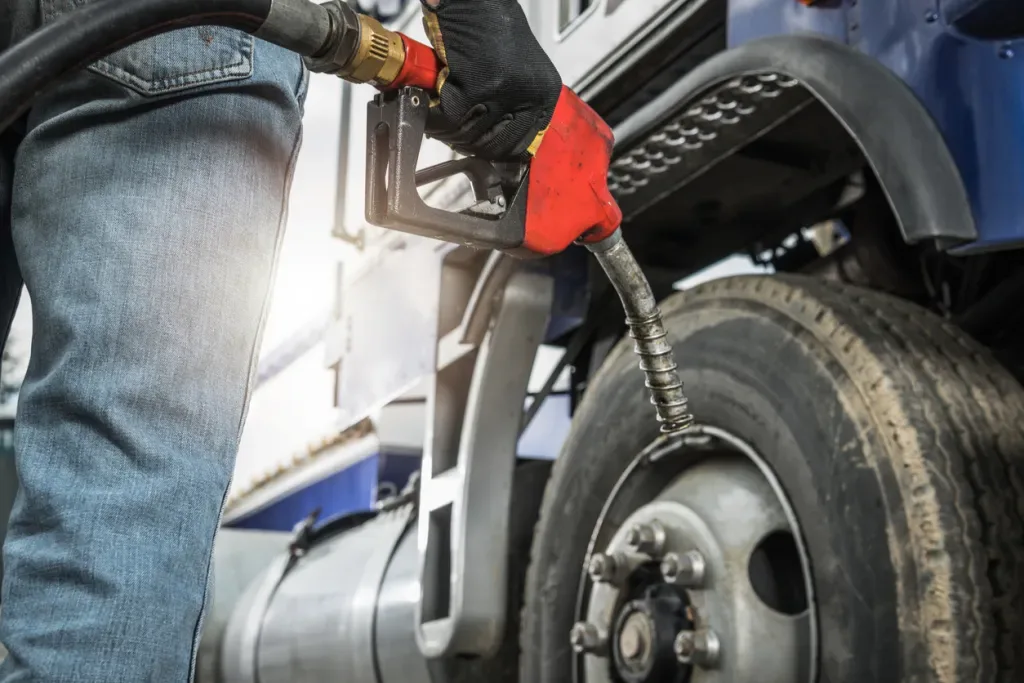Fueling an RV or large trailer in a truck lane can be convenient, but you better follow the rules. If not, you could find yourself face-to-face with an angry driver.
While big rigs and professional operators typically use them, these extra-large spaces are for recreational vehicles too. Like most things, there’s a right and wrong way to use them.
Today, we want to help you and your RV have a smooth experience using a truck lane.
Let’s get started!

Why Would RVers Use Truck Fuel Lanes?
RVers choose truck lanes for several reasons. For starters, they’re easier to get in and out of since stations designed these pumps for larger vehicles. Traffic is generally one-way, so you won’t have to worry about backing out when finished. There’s usually plenty of space to make any required turns or maneuvers.
These paths not only have more space horizontally but vertically as well. Some older gas station canopies are short and can create problems for taller trailers. The maximum legal height for towables is 13 feet, six inches. Low-hanging awnings can create issues for you and damage your RV if you’re not careful.
One of the biggest perks of using these spots is to pump fuel faster. Most standard gas pumps transfer at a rate of 10 gallons per minute. On the other hand, truck-specific options often have high-flow capabilities, upwards of 40 gallons per minute. In most passenger vehicle situations, you’ll fill your tank in under a minute.
These special paths also offer other convenient features. You might find windshield brushes with longer handles, non-potable water, and air for your tires. While they may not always be available, they can be helpful when they are.

5 RV Rules for Using Truck Lanes to Fuel Up
Professional drivers operate on very tight schedules. They usually don’t have patience for nonsense, and it can sometimes show. Stay on their good side by following these five RV rules for using truck lanes.
#1 Diesel-Powered RVs Only
One of the most important rules to follow for using truck lanes in your RV is that they’re for diesel-powered vehicles only. Semis and other big rigs rely on diesel fuel. You won’t find a standard gasoline pump in these areas. This helps avoid the potential of putting the wrong fuel into your tank, which can be a costly mistake.
Luckily, some service stations are installing RV-specific amenities. These pumps often have diesel and gasoline pumps, potable water, and a sewer connection.
However, you’ll have to pay additional fees for access to water or to dump your tanks. You can download your favorite truck stop apps and search for amenities at nearby locations.

#2 Be Patient
Pack your patience when driving your RV through a truck lane. Semis will take considerably longer to fill their tanks than a passenger vehicle. While it may only take a minute or two, professional operators can take ten to fifteen minutes. Truckers generally have specific tasks to complete every time they take a break.
At a typical stop, a driver will fill their tanks, clean the windshield, check the oil, and visually inspect their rig. Once they finish fueling up, they’ll pull forward and make a quick trip inside. Unfortunately, this can leave you stuck as there’s likely no room to maneuver around them.
Again, you must remain as patient as possible throughout the process. While it can be frustrating to wait on others, losing your cool won’t help the situation. Take a deep breath, put on some tunes, or enjoy a pre-trip snack.
#3 Wear Gloves
Another one of the RV truck lane rules you should follow is to wear gloves. The handles on fuel pumps can get extremely dirty. Diesel is greasier than gasoline and doesn’t evaporate as quickly. Simply touching the handle on a pump is enough to leave your hands slimy and smelly.
Wearing gloves reduces the chances of coming in contact with diesel. The contaminants and chemicals in this liquid can cause skin irritation. Some stations have gloves available at each fuel island.
If you use these pumps regularly, it may be worth investing in a box of nitrile gloves. When finished pumping, take them off and toss them in the trash.

#4 Use a Fuel Discount Card
Why pay more than you have to for your fuel? Consider getting a discount card if you’re tired of paying premium prices. The TSD Open Roads program is one of the most popular fuel cards for RVers. While discounts vary by location, using the program can help you save hundreds of dollars every year.
Another advantage of these discount cards is that you no longer have to go inside. Many stations require drivers to use standard credit cards to prepay for fuel. However, this card connects to your bank account and saves time and money each time you fill up.
#5 Pull Forward
The final RV truck lane rule you should follow is to pull forward when finished. You may need to go inside to get your receipt, visit the restroom, or grab something to eat. That’s fine and dandy, but don’t block traffic. You could return to find a very angry trucker waiting to give you a piece of their mind.
Pulling forward allows the driver behind you to go ahead and get started. When you return, there’s a good chance the person will still be pumping. If you plan to shower, do laundry, or take a cat nap, relocate to a more permanent parking spot.
It may be common sense, but you want to do all you can to avoid being in the way of others.
Follow the Unspoken Rules for RVs in Truck Lanes
Unfortunately, not everyone is kind and considerate enough to follow the rules of the road. Do your part and pack your patience, work efficiently, and get out of the way when you’re done.
Follow these RV truck lane rules, and you’ll likely have an uneventful experience. You can hit the road for your next adventure with a full fuel tank and a clear conscience!
We’ll Help You Find the Best Free Camping in the USA
You should give it a try!
As a matter of fact, these free campsites are yours to enjoy. Every time you pay federal taxes, you’re contributing to these lands.
Become a FREE CAMPING INSIDER and join the 100,000 campers who love to score the best site!
We’ll send you the 50 Best Free Campsites in the USA (one per state). Access the list by submitting your email below: